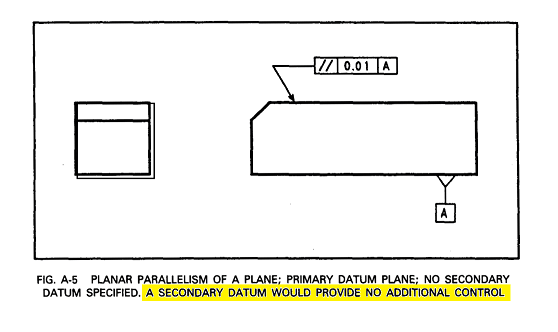What are the opinions on the following schemes?
1. Angularity control referencing 2 datums in the FCF, when the basic angle is specified between the controlled face and the secondary datum. The primary and the secondary datums are perpendicular to each other.
2. Parallelism control referencing 2 datums in the FCF, when the controlled face is nominally parallel to the secondary datum and perpendicular to the primary datum.
3. Perpendicularity control referencing 2 datums in the FCF, when the controlled feature is nominally perpendicular to the secondary datum and at some other angle to the primary datum.
I haven't seen any of these brought as an example in the Y14.5 standard (unless I'm missing one), or in any other sources I was exposed to, but I also don't see how the contents of chapter 6 may reject those schemes. Schemes #1 and #2 are ones I wanted to implement for real cases, but hesitated (eventually I did ). As for #3, I haven't encountered a case requiring this, but I can imagine one. I think I once heard a GD&T professional say that there should always be a basic implied 90° angle (for perpendicularity), or a basic angle of some other value (for angularity) between the controlled feature and the primary datum feature whereas the secondary datum may only constrain DOF / orient the tolerance zone. But, if the DRF should first and foremost reflect the functional interface, there certainly may be cases where a vice-versa scheme is justified. The problem is - there are no figures to point to if such position needs to be supported. In Y14.5, looking for orientation controls that reference more than one datum, I find only figures 6-4, 6-8, and even 6-17, all show an implied right angle relationship or basic angle between the controlled feature and the primary datum reference, never to the secondary.
). As for #3, I haven't encountered a case requiring this, but I can imagine one. I think I once heard a GD&T professional say that there should always be a basic implied 90° angle (for perpendicularity), or a basic angle of some other value (for angularity) between the controlled feature and the primary datum feature whereas the secondary datum may only constrain DOF / orient the tolerance zone. But, if the DRF should first and foremost reflect the functional interface, there certainly may be cases where a vice-versa scheme is justified. The problem is - there are no figures to point to if such position needs to be supported. In Y14.5, looking for orientation controls that reference more than one datum, I find only figures 6-4, 6-8, and even 6-17, all show an implied right angle relationship or basic angle between the controlled feature and the primary datum reference, never to the secondary.
Has anyone else dealt with this dilemma? Maybe it's only my lack of knowledge / experience, and such schemes are either commonly practiced or clearly not supported? Whatever the case is your input will be very much appreciated.
Edit: I'd like to add that I realize that one solution could be to use profile of a surface for orientation, but from various reasons I prefer to utilize orientation controls and reserve this solution only as a last resort, if needed.
1. Angularity control referencing 2 datums in the FCF, when the basic angle is specified between the controlled face and the secondary datum. The primary and the secondary datums are perpendicular to each other.
2. Parallelism control referencing 2 datums in the FCF, when the controlled face is nominally parallel to the secondary datum and perpendicular to the primary datum.
3. Perpendicularity control referencing 2 datums in the FCF, when the controlled feature is nominally perpendicular to the secondary datum and at some other angle to the primary datum.
I haven't seen any of these brought as an example in the Y14.5 standard (unless I'm missing one), or in any other sources I was exposed to, but I also don't see how the contents of chapter 6 may reject those schemes. Schemes #1 and #2 are ones I wanted to implement for real cases, but hesitated (eventually I did
Has anyone else dealt with this dilemma? Maybe it's only my lack of knowledge / experience, and such schemes are either commonly practiced or clearly not supported? Whatever the case is your input will be very much appreciated.
Edit: I'd like to add that I realize that one solution could be to use profile of a surface for orientation, but from various reasons I prefer to utilize orientation controls and reserve this solution only as a last resort, if needed.

